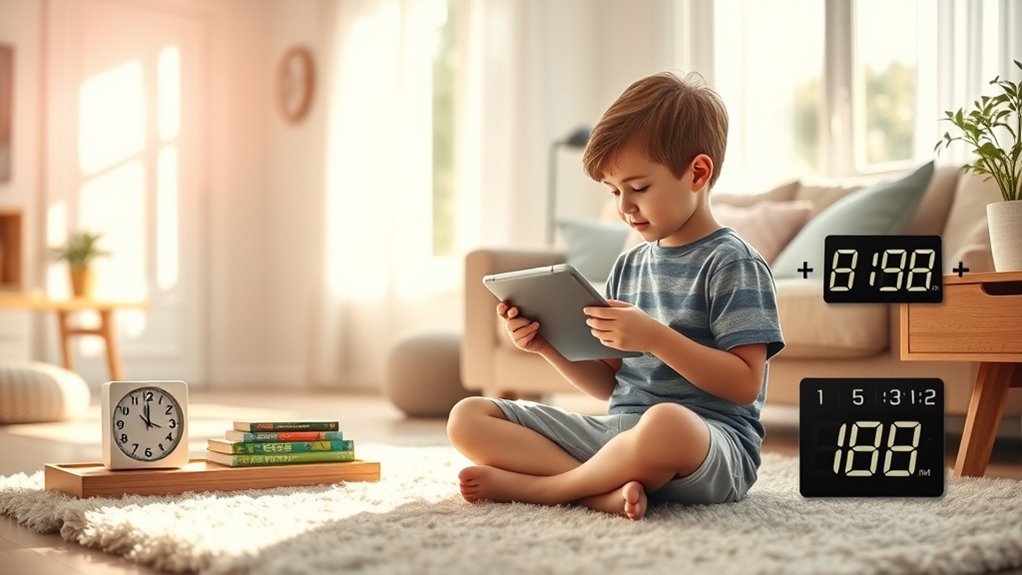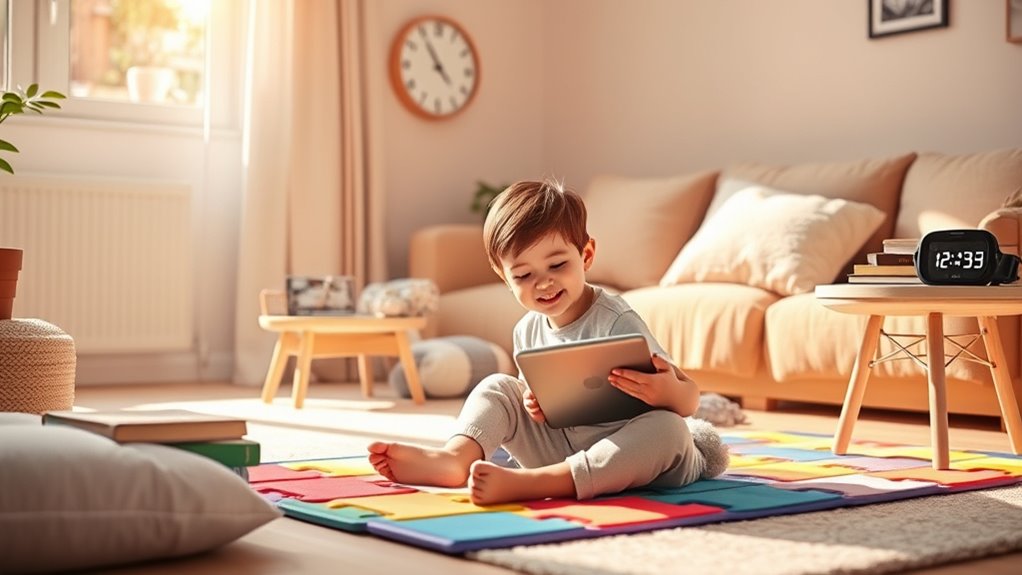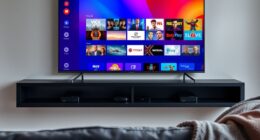To manage your kid’s screen time effectively, set clear boundaries like limiting daily entertainment use, no screens during meals, and creating designated screen-free zones. Encourage offline activities such as outdoor play, hobbies, or reading, and involve your child in choosing these activities. Use parental controls to monitor and restrict content, and model healthy habits yourself. Continuing further will reveal more practical strategies to help your family find a balanced digital routine.
Key Takeaways
- Set clear daily time limits and designate screen-free zones to encourage offline activities.
- Incorporate engaging hobbies like sports, arts, or reading to reduce reliance on screens.
- Use parental controls to monitor, restrict, and block inappropriate content during screen time.
- Prioritize educational and purposeful screen use, balancing it with creative and physical activities.
- Lead by example and schedule regular screen-free days to promote healthy digital habits and family bonding.

In today’s digital age, managing your child’s screen time is more important than ever. Kids are spending several hours each day glued to screens, with tweens averaging about five hours and older kids, like those in Generation Z, reaching nearly nine hours daily. This increase is concerning because excessive screen time is linked to lower attention spans, poorer academic performance, eye strain, sleep issues, and mental health challenges. As a parent, you need practical strategies to set boundaries and promote healthier habits.
Excessive screen time affects attention, sleep, and mental health—parents must set boundaries for healthier habits.
Start by setting clear daily limits for screen use. The general recommendation is to keep screen time over two hours daily in check, especially for entertainment purposes. Establish specific rules, such as no screens during meals or an hour before bedtime, to improve sleep quality and family interaction. Creating designated screen-free zones, like bedrooms or the dining area, helps reinforce these boundaries and encourages children to engage in offline activities.
Encouraging outdoor play and physical activities is vital. When you promote hobbies like sports, arts, or reading, you give your child alternatives that are both fun and beneficial for their development. Scheduling regular outdoor time reduces reliance on screens and supports their physical and mental health. Additionally, involving your child in choosing activities can foster a sense of ownership and motivation to stick to the rules.
Monitoring digital activities is essential. Use parental control software or apps that track and limit screen time, block inappropriate content, and provide insights into what your child is doing online. Open communication is equally important—talk with your kids about why these boundaries matter and listen to their perspectives. Modeling healthy screen habits yourself sets a strong example; if they see you limiting your own device use, they’re more likely to follow suit.
Educational content can be a useful tool. Incorporate apps and programs that promote learning, and use screen time as an opportunity rather than just entertainment. Many schools face challenges with students who spend too much time on screens, so integrating digital literacy into their routine helps them develop critical skills. Parents can also set aside designated times for screen-based learning, ensuring it feels purposeful rather than excessive.
Finally, balance is key. Encourage hobbies, reading, and creative pursuits that don’t involve screens. Schedule regular screen-free days or times to give your child a break and foster family interactions. Being aware of the impact of brain fog and other cognitive effects related to excessive screen use can help you make more informed decisions about limiting screen time. By actively managing screen time and leading by example, you help your child develop healthier digital habits that support their overall well-being.
Frequently Asked Questions
How Can I Monitor My Child’s Online Activity Effectively?
To monitor your child’s online activity effectively, start by using parental control software to block inappropriate content and set time limits. Combine this with regular checks of browsing history and app usage. Have open conversations about online safety, and set clear household rules tailored to their age. Stay consistent with enforcement and encourage trust-building discussions, so your child feels comfortable sharing online experiences and concerns.
What Are Healthy Alternatives to Screen Time?
Think of screens as windows to the world, but too much can trap your child indoors. You can open the door to healthier alternatives like outdoor play, sports, or creative pursuits such as drawing, reading, or dancing. These activities serve as bridges to physical health, social skills, and imagination. By encouraging these, you help your child explore life’s full landscape, fostering growth beyond the digital window.
How Do I Handle Resistance to Screen Time Limits?
When your child resists screen time limits, stay patient and consistent. Talk to them about why limits matter and involve them in setting rules. Offer appealing alternatives like outdoor play or reading to make the shift smoother. Model responsible screen habits yourself and enforce rules calmly. Remember, gradual adjustments and positive reinforcement help your child accept boundaries and develop healthier habits over time.
Are There Specific Apps to Help Manage Screen Time?
Think of managing screen time like steering a ship through calm waters. Parental control apps act as your compass, guiding you safely. Qustodio, Net Nanny, and Norton Family are like sturdy anchors, offering web filtering, app blocking, and location tracking to keep your child on course. With features like real-time alerts and remote controls, you’re always in command, ensuring smooth sailing in your child’s digital adventure.
How Does Screen Time Affect My Child’s Sleep Patterns?
Screen time substantially impacts your child’s sleep patterns. Excessive or interactive screen use delays bedtime by about 30 minutes, reduces sleep duration, and increases nighttime awakenings. Blue light from screens suppresses melatonin, making it harder to fall asleep. Kids with high screen time also experience more daytime sleepiness and less restful sleep. Limiting screen exposure, especially before bed, can improve their sleep quality and overall health.
Conclusion
So, now that you know these tips, are you ready to take control of your child’s screen time? The next step could change your family’s routine forever. Will a simple change make a big difference? Or is there a challenge lurking just around the corner? Stay vigilant and prepared—you never know when the next screen-time dilemma will strike. The key is staying one step ahead, ready to adapt and keep your kids balanced and happy.










